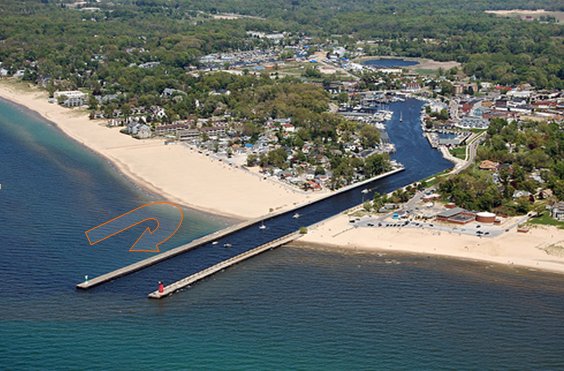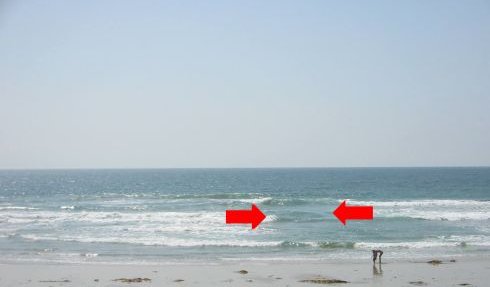Rip currents can occur along any coastline that features
breaking waves. Scientific investigations of wave and current
interactions along the coast have shown that rip currents are
likely present on most beaches every day as a component of the
complex pattern of nearshore circulation.
As waves travel from deep to shallow water, they eventually
break near the shoreline. As waves break, they generate currents
that flow in both the offshore (away from the coast) and the
alongshore directions. Currents flowing away from the coast are
called rip currents.
Rip currents are a result of complex interactions between waves,
currents, water levels and nearshore bathymetry. These current
systems form an integral part of nearshore circulation patterns
such as alongshore and cross-shore (onshore/offshore) water motion.
Along all coastlines, nearshore circulation cells may develop when
waves break strongly in some locations and weakly in others. These
weaker and stronger wave breaking patterns are most often seen on
beaches with a sand bar and channel system in the nearshore zone. A
rip current forms as the narrow, fast-moving section of water
travels in an offshore direction. Rip currents can also result from
a wave's natural variability or when a current traveling along the
shoreline encounters a structure of some sort and is forced
offshore. Rip Currents can also occur in waters adjacent to
seawalls, artificial reefs, and erosion control structures.
Rip current strength and speed varies. This variability makes
rip currents especially dangerous to uninformed beachgoers. Rapid
fluctuations or pulses in wave groups can quickly generate rip
currents with velocities measured up to 8 feet per second.
Basic Rip Current Mechanics
• Waves break on the sand bars before they break in the channel
area.
• Wave breaking causes an increase in water level over the bars
relative to the channel level.
• Water is pushed over the submerged sandbar but cannot easily
return lakeward. Excess water is held on the beach slightly above
the normal lake level by the addition of water from the on-coming
waves.
• A pressure gradient is created due to the higher water level over
the bars.
• This pressure gradient drives a current alongshore (the feeder
current).
• Water rushing back into the lake "rips" an opening in the sandbar
(much like pulling the plug in a bathtub).
• The longshore currents converge and turn seaward, flowing through
the low area or channel between the sand bars.
The shape of the shoreline and nearshore bottom (bathymetry) may
influence rip current development.
The presence of longshore bars can also have an impact on rip
current development and location. In some geographic locations, the
nearshore bottom may be characterized by fixed structures such as
reefs. Due to the mechanics of wave action and currents offshore
sand bars are constantly changing their shape and location which
can affect from day to day rip currents that seem to move to
different spots on the beach. Along shorelines where sand is
deposited in an offshore bar, the rip current often flows through a
low spot or channel cut through the sandbar.
Rip currents can be extremely dangerous. Currents can drag
swimmers away from the beach area and out to open water leading to
death by drowning. Typically such swimmers will attempt to fight
the current and become physically exhausted and can no longer stay
afloat and then leads to their drowning. Some beaches have stronger
rip currents than others. It depends on the topography of the area.
Strong rip currents have been known drag someone who was standing
in the water knocking them down and then out to sea.
Swimmers have occasionally described a force that "sucks" or
"tows" swimmers under the water. This has been referred to as an
"undertow." In reality, there is no such thing as an undertow. The
force that most waders feel pulling at their legs in shallow water
is the "back wash" from a wave that has washed up on the beach.
This force can cause a person to lose their balance and even fall
down in the surf. Small children are particularly at risk from this
force. Swimmers and waders near an opening in the sand bar may
become caught in the strong flow of the rip current and be carried
beyond the sandbar to deep water.
Rip currents cause approximately 100 deaths annually in the
United States, more than all other natural hazards except heat and
floods. Locally, rip currents have claimed multiple lives. In July
of 2003, near St. Joseph, 7 people drowned from rip currents in a
single day. Structural elements such as the pier here on the North
Beach are very susceptible to strong rip currents. What happens is
the long shore currents coming in from the lake hit the pier and
then have to stop. They have to go somewhere! As a result of the
water building up when it hits the pier – it heads back out to
deeper waters in Lake Michigan. This activity occurs all year long
– not just during the warm swimming months of summer. Also, if you
look at the below photo – you should be able to view the sandbars
(look for the brown color in the photo). Anytime a break in one of
the sandbars occurs – a rip current is then formed and water will
rapidly move out to the deeper waters of Lake Michigan carrying
anyone in it’s path.

The National Oceanic and Atmospheric Administration
advises that rip currents can be identified by:
• A channel of churning, choppy water.
• An area having a notable difference in water color (sand may be
getting kicked up).
• A line of foam, seaweed, or debris moving steadily seaward.
• A break in the incoming wave pattern.

Rip Current Safety tips
Read any posted warnings and follow them closely. It is also
advisable to stay at least 100 feet away from piers and jetties
which impede waves and encourages rip currents to form. Check the
internet and/or local papers for information on tide timetables.
Follow all lifeguard warnings and/or signage. Best practice is to
swim at beaches with lifeguards. Know the flag system. Green means
you can swim. Red means don’t swim. The United States Lifesaving
Association has calculated the chance that a person will drown
while attending a beach protected by USLA affiliated lifeguards at
1 in 18 million. If caught in a rip current at an unguarded beach,
how you respond (don't panic and fight the current even though it
is a natural response) could make the difference between life and
death.
To Log this cache:
1. Please post a photo with you and/or your team with faces clearly
showing at this location and Lake Michigan in the background.
2. On the sign are measures you can take to get out of a RIP
current and other safety measures. Please note at least 3 measures
you can take.
3. Can you observe any noticeable rip currents at the time of your
visit? Can you notice more than one? Snap a photo and post it with
your log if you are able.
4. Using my profile – please email the answers to 2 & 3. Do not
post your answers with your log.
Each Cacher that logs a find is required to submit answers to
the questions above (failure to comply will result in a deletion of
your log). The only exception to this are young kids that are
caching with their parents (who have their own account, but not
computer privileges). Per Earthcache guidelines, each cacher is to
learn from their visit/experience. That means each cacher must
perform the necessary task(s) or requirements to log the cache and
earn your smiley.
Any logs that do not meet the above posted requirements will be
deleted at the discretion of the cache owner. All logging
requirements must be completed within 48 hours of logging the cache
online or your log will be deleted unless you have prior permission
from the cache owner.